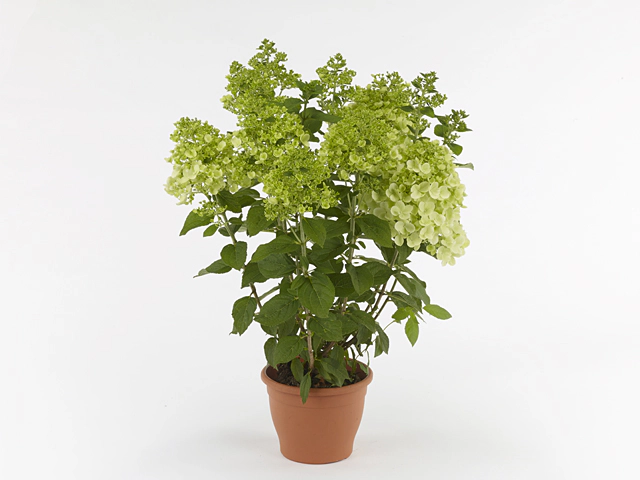Hydrangea paniculata Pantera

| Flower type | Single |
| Leaf margin | Serrate |
| Winter hardness | Excellent (USDA-zone 1,2,3,4) |
| Flower color | Green-light green-145D |
| Leaf, general shape | Elliptic / oval |
| Petal edge | Entire |
| Flower diameter | 4 - 4,5 cm |
| Plant height | 40 - 50 cm; 80 - 90 cm; 90 - 100 cm |
| Inflorescence | Panicle |
| Flowering month(s) | September; October; June; July; August |
| Leaf width | 5 - 7,5 cm |
| Leaf duration | Deciduous |
| Leaf size | 7,5 - 10 cm |
| soil pH requirement | Alkaline (pH > 7,5); Slightly acidic (pH 4,5 - 6,5); Neutral (pH 6,5 - 7,5) |
| Light conditions | Sunny; Semi-shades |
| Inflorescence diameter | 15 - 20 cm |
| Leaf, main color | Dark green |
| Flower color distribution | Unicolored |
| Moisture requirements | Well-drained; Moist |
Hydrangea paniculata Pantera, commonly known as the Pantera Hydrangea, is a beautiful flowering plant that is sure to add charm to any garden or landscape. With its single-flower type and serrated leaf margins, it stands out as an elegant addition.
One of the notable features of the Pantera Hydrangea is its excellent winter hardness. It is capable of thriving in USDA zones 1, 2, 3, and 4, making it a great choice for those living in colder regions. This plant can withstand harsh winters and still bloom beautifully when the warmer months arrive.
The flowers of the Pantera Hydrangea are characterized by their green-light green coloration, specifically 145D on the color spectrum. The flower diameter ranges from 4 to 4.5 cm, and they form in panicles, creating a stunning display during the flowering months of June, July, August, September, and October.
The leaves of this hydrangea variety are elliptic/oval in shape, with entire petal edges. They have a dark green main color and a width of 5 to 7.5 cm. The leaves are deciduous, meaning that they will shed during the winter months.
In terms of size, the Pantera Hydrangea can reach heights of 40 to 50 cm, 80 to 90 cm, or 90 to 100 cm, depending on the specific cultivar. This variability allows for flexibility in planting arrangements and ensures that it can fit various garden designs.
When it comes to soil conditions, this hydrangea prefers alkaline soil with a pH greater than 7.5 or slightly acidic soil with a pH ranging from 4.5 to 6.5. It can also tolerate neutral soil with a pH between 6.5 and 7.5. This adaptability makes it suitable for a wide range of gardening environments.
The Pantera Hydrangea thrives in both sunny and semi-shaded areas, ensuring that it can be placed in various spots within a garden or landscape. It can tolerate different light conditions, making it a versatile plant choice.
The inflorescence of the Pantera Hydrangea is quite impressive, with a diameter ranging from 15 to 20 cm. The large and vibrant clusters of flowers create a striking visual impact, attracting attention and adding a pop of color to the garden.
To ensure the healthy growth of the Pantera Hydrangea, it requires well-drained and moist soil. Proper irrigation and regular watering are essential to maintain its moisture requirements.
In conclusion, the Pantera Hydrangea is an exquisite plant with single flowers and serrated leaves. Its excellent winter hardiness, green-light green flower coloration, and panicle inflorescence make it a standout choice for gardens or landscapes. With its adaptability to different soil and light conditions, it can thrive in various environments. If you are looking for a stunning flowering plant with a touch of elegance, the Pantera Hydrangea is the perfect choice.
Market availability index by month:
| Jan. | Feb. | Mar. | Apr. | May | Jun. | Jul. | Aug. | Sep. | Oct. | Nov. | Dec. |
|---|---|---|---|---|---|---|---|---|---|---|---|
| 1 | 1 | 1 | 2 | 2 | 3 | 4 | 4 | 2 | 1 | 1 | 1 |